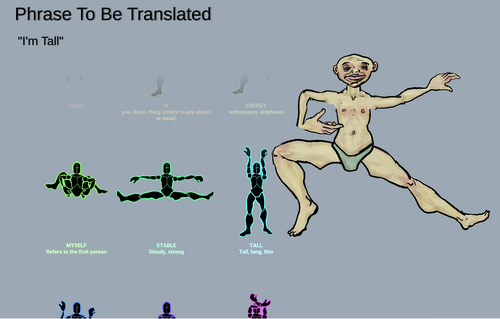design journal -- dance of a translator

Process — Dance of a Translator
Dance of a Translator was original envisioned as a Kinect based game in which input would be embodied. Due to technical troubles I had with Kinect’s gesture recognition and time mismanagement I decided that I would have to abandon the Kinect as the games primary input. I first spent time designing systems and envisioning props which could translate the idea into a two-person physical game in which one player would take on the role of the judge. The dynamic changed so drastically once the judge became fallible, however, that I couldn’t find a way to adapt the concept to a physical context without making the game unrecognizable from the project proposal. I was also less comfortable with designing mimicry-based, role-playing games.
I decided that the player would indirectly control an avatar who would perform gestures instead of you. I settled on the two-controller setup because it seemed a way to sort of cheat and make an altcontroller without needing any of the technical craftsmanship which would be required to actually construct an apparatus or soft controller from scratch. Hopefully my makeshift “alt”-controller serves its purpose in defamiliarizing experienced players as they won’t have the countless hours of muscle memory that they are used to having with standard input devices. Also, hopefully it does end up providing a relatively embodied experience (compared to a standard controller) because it requires the participation of two whole hands instead of just fingers.
I experimented with a couple different ways of recognizing gestures before settling on a method which looks at the angles of each joint to make determine whether the player is performing any particular gesture. I then drew a character and rigged them. This is the first time I’ve drawn a figure in my art style for a game and while I enjoyed the aesthetic, because the people I draw look peculiar and a little alien and think the drawing might lead to narrative confusion and take attention away from the core mechanics of the game. The vast majority of the time spent on this project was spent implementing the core mechanics of gesture performance, gesture recognition, gesture creation (on the designer’s end), and the displaying of gestures in a dictionary.
Design wise, my time spent was struggling between how much immediate feedback I should give players. Growing up playing juicy games like Nuculear Throne (Vlambeer, 2015) my instinct is always to provide as much and as loud feedback as to user inputs and progression. But in this project game juice and input clarity seemed in direct contradiction to the intended design aesthetic spelt out in my project proposal. I ended up telling the players what the game registered as a gesture at the end of each recording. This, however, makes the actual process of translation ambiguous and kind of frustrating as you don’t know if the intended gestures are being recognized until at the end. This undoubtedly negatively impacts how enjoyable the game is, but I think this is OK, given the emphasis on rhetoric of this class.
Finally, while I didn’t end up having time to add much narrative framing and/or progression, I nevertheless think this prototype show the core ideas of gesture manipulation (via the controllers) and gesture recognition, to be promising and worth pursuing at a future date. I was particularly surprised at how well the gesture recognition which seemed to work, considering the simplicity of the system, the lack of time I spent tuning values, and the lack of player feedback.
Files
Get dance of a translator
dance of a translator
translate English into an alien language using your body.
| Status | Released |
| Author | Charly Yan Miller |
Leave a comment
Log in with itch.io to leave a comment.